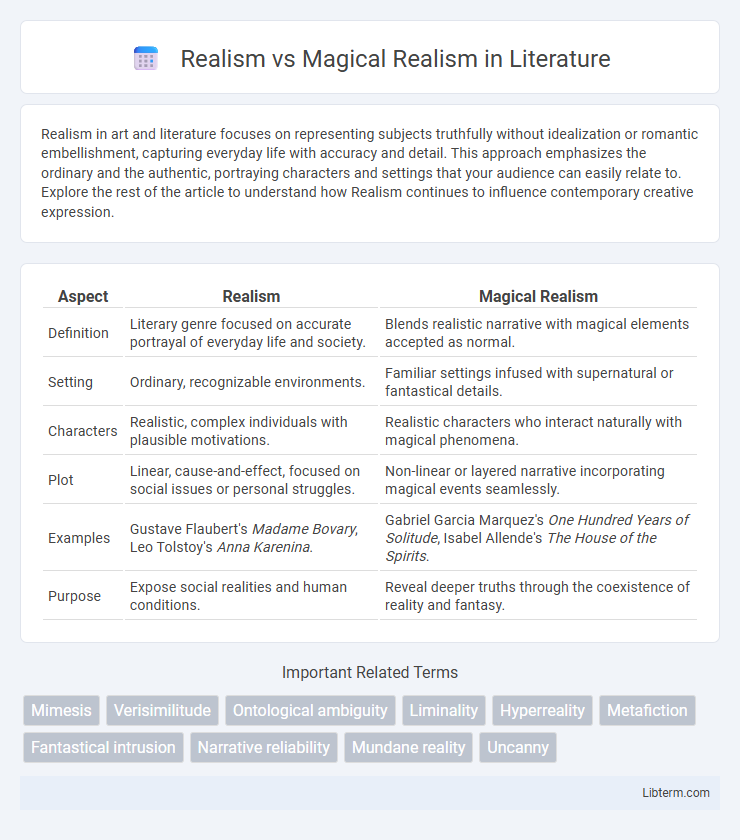Realism in art and literature focuses on representing subjects truthfully without idealization or romantic embellishment, capturing everyday life with accuracy and detail. This approach emphasizes the ordinary and the authentic, portraying characters and settings that your audience can easily relate to. Explore the rest of the article to understand how Realism continues to influence contemporary creative expression.
Table of Comparison
| Aspect | Realism | Magical Realism |
|---|---|---|
| Definition | Literary genre focused on accurate portrayal of everyday life and society. | Blends realistic narrative with magical elements accepted as normal. |
| Setting | Ordinary, recognizable environments. | Familiar settings infused with supernatural or fantastical details. |
| Characters | Realistic, complex individuals with plausible motivations. | Realistic characters who interact naturally with magical phenomena. |
| Plot | Linear, cause-and-effect, focused on social issues or personal struggles. | Non-linear or layered narrative incorporating magical events seamlessly. |
| Examples | Gustave Flaubert's Madame Bovary, Leo Tolstoy's Anna Karenina. | Gabriel Garcia Marquez's One Hundred Years of Solitude, Isabel Allende's The House of the Spirits. |
| Purpose | Expose social realities and human conditions. | Reveal deeper truths through the coexistence of reality and fantasy. |
Defining Realism: A Foundation in the Tangible
Realism in literature emphasizes meticulous depiction of everyday life, prioritizing accurate, detailed representations of the external world and social conditions. This literary approach grounds narratives in tangible experiences, focusing on ordinary characters and plausible events to reveal truths about society. The foundation of realism lies in its commitment to objective observation, rejecting supernatural elements to maintain credibility and relatability.
Key Characteristics of Magical Realism
Magical realism blends realistic narrative with surreal elements, integrating magical occurrences as a natural part of the mundane world, unlike realism which strictly adheres to plausible events. Key characteristics of magical realism include the coexistence of the extraordinary and the ordinary, an acceptance of magic as reality, and detailed, sensory descriptions that ground fantastical elements in everyday life. This genre often features mythical creatures, supernatural events, or dream-like scenarios presented without question, creating a seamless fusion of reality and fantasy.
Origins and Historical Context
Realism originated in the mid-19th century as a literary movement emphasizing accurate, detailed representations of everyday life and society, reacting against romanticism's idealization. Magical realism emerged in the early 20th century, particularly in Latin America, blending realistic narrative with fantastical elements rooted in indigenous myths and cultural hybridity. Both movements reflect their historical contexts: Realism during industrialization and social change in Europe, and Magical realism amid postcolonial identity and political upheaval in Latin America.
Prominent Authors and Notable Works
Realism features prominent authors like Gustave Flaubert with "Madame Bovary" and Leo Tolstoy with "War and Peace," emphasizing detailed depictions of everyday life and social realities. Magical Realism is exemplified by Gabriel Garcia Marquez's "One Hundred Years of Solitude" and Isabel Allende's "The House of the Spirits," blending fantastical elements with realistic narratives to explore cultural and political themes. Both literary movements have defined modern literature through their distinct approaches to storytelling and representation.
Narrative Techniques: Reality vs the Extraordinary
Realism employs detailed, plausible narratives grounded in everyday experiences, emphasizing authentic character development and logical cause-effect relationships. Magical realism integrates fantastical elements seamlessly into a realistic setting, treating extraordinary occurrences as normal and blurring the line between reality and fantasy. This narrative technique challenges readers' perceptions by combining objective reality with mythic or supernatural components, enriching thematic complexity and cultural symbolism.
Themes Explored: Truths, Myths, and Social Commentary
Realism emphasizes objective truths and everyday experiences, grounding narratives in social realities and detailed depictions of common life. Magical realism blends factual elements with mythical or fantastical features, exploring deeper cultural myths and symbolizing complex social issues through surreal or magical occurrences. Both genres offer incisive social commentary, but realism critiques societal structures through concrete representation, while magical realism reveals hidden truths by intertwining reality with imaginative layers.
The Role of Setting in Both Genres
In Realism, the setting is meticulously detailed to reflect everyday life and social conditions, grounding the narrative in a recognizable, authentic world. Magical Realism blends realistic settings with fantastical elements, creating a seamless environment where the extraordinary coexists naturally with the ordinary. This fusion of familiar landscapes and supernatural events challenges the reader's perception of reality, emphasizing cultural and symbolic significance embedded in the setting.
Impact on Modern Literature and Culture
Realism, characterized by its accurate depiction of everyday life, profoundly shaped modern literature by emphasizing social issues and human psychology, influencing writers such as Henry James and Gustave Flaubert. Magical Realism, blending fantastical elements with realistic settings, revolutionized narrative techniques and cultural expression, with iconic authors like Gabriel Garcia Marquez and Salman Rushdie expanding the boundaries of storytelling. Both genres continue to impact modern literature and culture by challenging perceptions of reality and reflecting complex societal truths.
Reader Perception and Emotional Engagement
Realism grounds the narrative in everyday experiences, encouraging readers to relate through plausible scenarios and authentic character emotions, fostering a deep sense of empathy and intellectual engagement. Magical realism intertwines fantastical elements with realistic settings, challenging readers' perceptions by blending the extraordinary seamlessly into the ordinary, enhancing emotional resonance through symbolic and imaginative layers. This fusion stimulates readers' curiosity and emotional complexity by expanding interpretative possibilities beyond conventional realism.
Choosing Between Realism and Magical Realism
Choosing between realism and magical realism depends on the narrative goals and the desired impact on the reader's perception of reality. Realism emphasizes detailed, everyday experiences and plausible events to create a relatable and grounded story, while magical realism integrates fantastical elements into a realistic setting, enriching the narrative with symbolic and metaphorical depth. Writers select magical realism when aiming to explore complex truths and cultural nuances beyond the limitations of strict realism.
Realism Infographic

 libterm.com
libterm.com